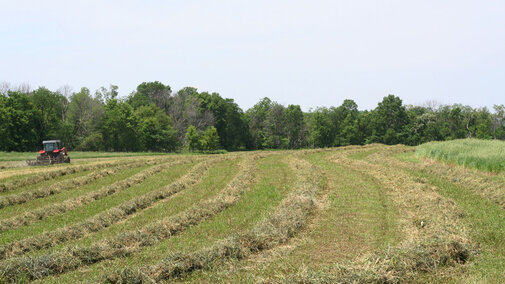Small Grain Forage Harvest
Despite a cool start to the season, many small grains are maturing fast and nearing harvest windows. Are you ready to make the most out of these forage options?
Producers seeking hay should consider the animal being fed and feeding method before harvesting. For young growing cattle, small grain hay should be cut in the boot stage or as soon as possible following heading to ensure higher protein and energy content. Mature cow and feedlot managers may consider delaying their forage harvest until the hard dough development stage to increase forage quantity since these cattle can utilize lower quality forage than younger beef animals. Small grains with awns like rye, triticale and wheat can be a concern at later maturities. Grinding the hay, feeding in ration with additional moisture or using an awnless (beardless) variety can reduce this risk.
No matter how you harvest, delaying can mean higher productivity. Nebraska studies have shown an eight-ton-per-acre increase between harvest at boot stage and soft dough on irrigated fields.
The trade-off for delaying forage harvest was an 8% drop in crude protein content.
Another concern for silage harvesters is proper moisture when packing. A statewide study looking at 17 Nebraska producers found the biggest loss of small grain silage quality was packing too wet despite almost all producers having wilted the crop before packing. Silage packed too wet had almost three times the energy loss that those packed at proper moisture content. Shoot for 70-72% moisture for proper packing. Study survey data showed producers who harvested at boot, heading or pollination stage and wilted for 16 to 24 hours appeared more likely to achieve target moisture levels.
Grass Hay Harvest
Smooth bromegrass and other cool-season grass hay fields are growing rapidly and seedheads will soon be appearing. When do you typically cut your grass hay? Ideally, cutting your grass hay so the grass nutrient content matches with the nutritional needs of your livestock is best.
Crude protein and energy concentration declines in grass hay as plants become stemmy and mature. With smooth bromegrass for example, research has shown that crude protein content declines rapidly between boot and mature seed stages. Crude protein levels in well fertilized hay harvested at early heading range from 10–18% but drop rapidly after heading. Decreases in crude protein levels by as much as one-half percent per day after heading have been recorded.
As this happens, the types of livestock that can be fed that hay with little or no supplements become more limited.
For Sandhills sub-irrigated meadows, haying typically starts in early July. However, if harvest occurs around the third week of June, then that hay will have significantly higher crude protein content. Earlier meadow harvest will have lower initial hay yield, but it will also provide a longer regrowth period and extra growth for fall grazing.
So, a good approach is to plan what type of livestock will receive the grass hay from each field. Young livestock need high nutrient concentrations so cut that hay before or just when heads begin to emerge. If the hay will go to mature dry cows instead, let the grass produce a bit more tonnage and cut it after it is well headed out, but before seeds develop.
Matching your hay harvest with your plan of use can pay handsome dividends in lower costs and less supplementing.
Cost of Fencing
Fencing costs are one of the more expensive aspects of grazing livestock. There are many factors that impact fencing costs including materials, the shape of the paddock or field, and labor required. UNL is gathering data to help calculate costs for fencing and other livestock services.
According to a 2002 UNL survey, the average cost of fencing a four-strand barbed wire fence (including the wire, line posts, labor and other miscellaneous materials and supplies) was $0.93/ft or $1,224 for a quarter of a mile for fencing. Adjusting for inflation, those prices would be $1.49/ft and $1,957 per quarter mile.
High-tensile electric fences combine the advantages of lower-cost wire and the need for fewer posts. The average cost in 2002 was $0.98/ft or $1,288 for a fourth mile. Adjusting for inflation, the prices would be $1.57/ft or $2,069 per quarter mile.
Single wire electric on average was $0.05/ft for materials, with 30-foot post spacing $0.06/ft and 60-foot post spacing $0.05/ft. Based on inflation adjustments the cost would be $0.08/ft for materials, $0.10/ft for 30-foot post spacing and $0.08 for 60-foot post spacing.
While the data shared is from 2002, we are working to update our published fencing and livestock costs with a new survey available to fill out for both service providers and users. Data provided is aggregated to maintain confidentiality and increases the accuracy of the information we can report later. If you would like to participate, please contact Glennis McClure at the Center for Ag Profitability.

